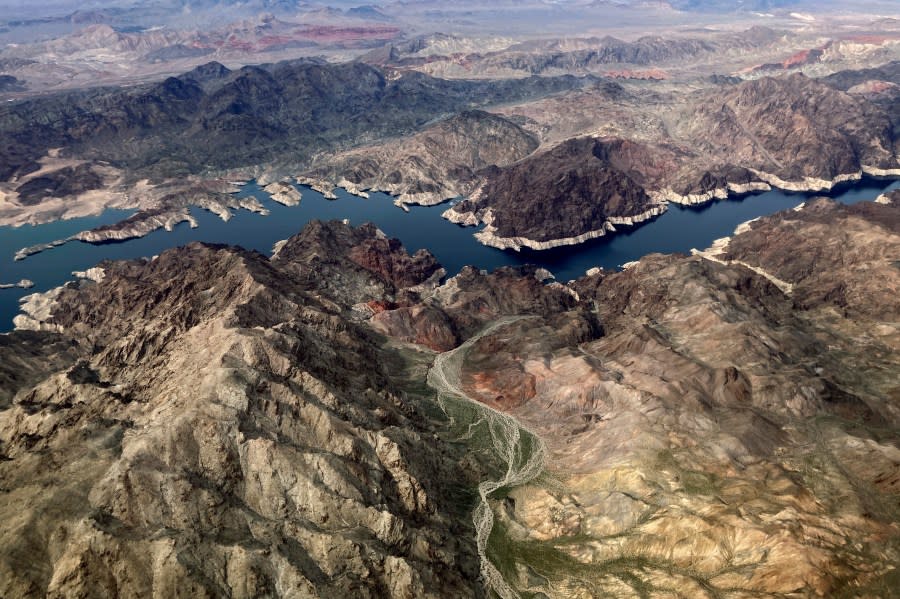LAS VEGAS (KLAS) — By the middle of the century, it’s going to be a lot hotter in Las Vegas, according to climate change models that were discussed this week at the 2024 Water Summit.
“We’re going to see a month more 100 degree days by mid-century,” Colby Pellegrino, deputy general manager at the Southern Nevada Water Authority, said during a panel discussion at the Springs Preserve on Wednesday. She was talking about how climate change impacts Las Vegas and the Colorado River, where 90% of the valley’s water comes from.
Climate change models indicate temperatures will increase by 7 to 9 degrees, Pellegrino said.

And this year’s record-breaking temperatures are giving us an early glimpse of what’s ahead.
Las Vegas hit 120 degrees in July, shattering the all-time high temperature record, which stood for years at 117. And while August is always hot, it feels like we just haven’t had a break this summer.
8 News Now Chief Meteorologist Tedd Florendo said the predictions don’t surprise him.
“We just broke the all-time record. It was the hottest July. Hottest June. The most 115-degree days in a row. The most 110-degree days. How’s that going to change?”
The Colorado River Basin is about 2.5 degrees hotter now than it was at the start of the “megadrought” that began in 2000. That heating is attributed to climate change. And while a 20-plus year drought didn’t sneak up on anyone, the change at Lake Mead is still a startling sight, with the reservoir only 33% full and the bathtub ring now a staggering 167 feet tall.


The Water Summit highlighted progress in conservation and infrastructure projects that will help save water by eliminating leaks, seepage and wasteful outdoor water use. The summit came the day before the U.S. Bureau of Reclamation announced water shortage restrictions in the desert Southwest.
Now it’s official: Las Vegas will be under Tier 1 restrictions as the water shortage enters its fourth year.
But what is Tier 1, and how does that affect the Las Vegas valley? The simple answer is that nothing changes because we’ve been under a Tier 1 shortage since the start of this year. Before that, we were in a more severe Tier 2a shortage to start 2023. But what’s next?
“Most probable” models for the Colorado River project that the Tier 1 shortage will persist for the next five years. The decision is made each August as the U.S. Bureau of Reclamation looks ahead to what the models say about the lake’s level in the year ahead. Water shortage tiers kick in when that projection shows Lake Mead’s surface under 1,075 feet elevation.
The first shortage in 2022 was at Tier 1. Conditions that year led to a Tier 2a shortage for 2023 — the deepest it’s been. But a wet winter brought snowpack levels in the Upper Colorado River Basin that were 160% of normal, and the shortage was reduced to Tier 1 for 2024. On Thursday, Reclamation set the shortage at Tier 1 for 2025.
Before the water shortage, the base allocations of Colorado River water looked like this:
-
Arizona: 2.8 million acre-feet
-
California: 4.4 million acre-feet
-
Nevada: 300,000 acre-feet
That all changed in August 2021 when the federal government declared the first shortage, projecting that Lake Mead would be below 1,075 feet on Jan. 1, 2022. The changes to the base allocations (the same as cuts that are in place now and for 2025):
-
Arizona: 2.2 million acre-feet (loses 512,000 acre-feet, an 18% reduction)
-
California: 4.4 million acre-feet (no change, senior water rights)
-
Nevada: 279,000 acre-feet (loses 21,000 acre-feet, a 7% reduction)
At the time, Lake Mead was at 1,067.80 feet, but within a year it would drop to its lowest point since it was filled in 1937: 1,041.71 feet on July 27, 2022. A few weeks later, the announcement came that 2023 would be under a Tier 2a shortage.
For Southern Nevada, the Tier 2a shortage meant an additional reduction of 4,000 acre-feet, Here are the changes to the base allocations under Tier 2a:
-
Arizona: (loses 592,000 acre-feet, a 34% reduction)
-
California: (no change, senior water rights)
-
Nevada: (loses 25,000 acre-feet, an 8% reduction)
Conservationists are skeptical of the “most probable” projections and warn that a couple of bad winters will put us right back at Tier 2a — and maybe worse.
The snowpack in 2023 and a better-than-normal 2024 (snowpack at 111%) at least bought some time for Reclamation to negotiate with states and tribes to craft new solutions for managing the river. Agreements that expire at the end of 2026 will be replaced by new rules for the Colorado River Basin. Conservation that happened under the stress of Lake Mead’s decline taught us that it’s possible to save more water — and still grow.
But Pellegrino said it’s hard to convince people that they can still save more. She expects this round of negotiations to be the most difficult.
U.S. Rep. Susie Lee (D-Nev.) hosted the summit and said Nevadans are paying attention.
“When I talk to my constituents there’s generally a concern about water and about climate change. We’ve seen 120 degree days here in Southern Nevada. And so we live in one of the most warming cities — the most warming city in the country. So clearly it’s on people’s mind. People understand,” she said.
“More importantly, people are seeing the impacts of the investments that we’ve been able to make and I think that has an impact as well,” Lee said.
Copyright 2024 Nexstar Media, Inc. All rights reserved. This material may not be published, broadcast, rewritten, or redistributed.
For the latest news, weather, sports, and streaming video, head to KLAS.
Source Agencies


